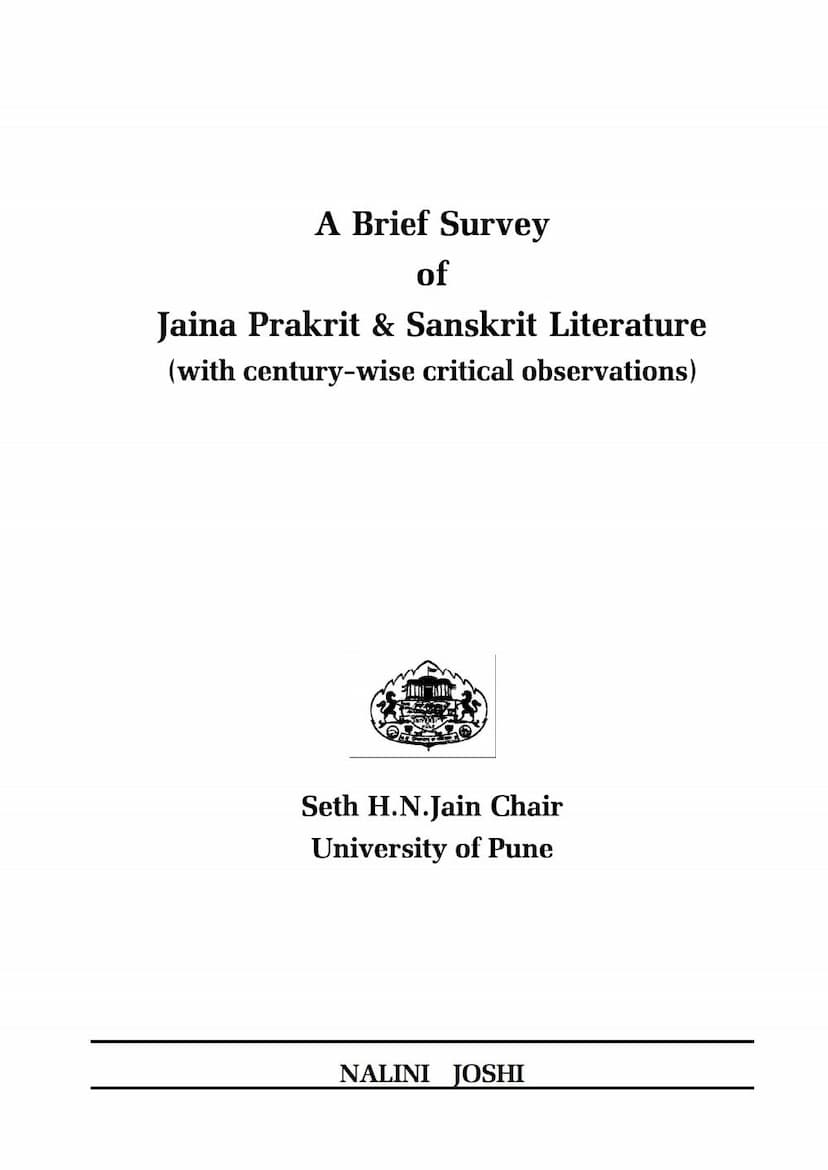Brief Survey Of Jaina Prakrit And Sanskrit Literature Part 1
Added to library: September 1, 2025

Summary
Here is a comprehensive summary of the provided pages from "A Brief Survey of Jaina Prakrit & Sanskrit Literature (with century-wise critical observations)" by Nalini Joshi:
This book, published in June 2009 by Sanmati-Teerth Prakashan, Pune, offers a unique and systematic survey of Jaina literature written in five Middle Indo-Aryan languages: Ardhamāgadhi (AMg.), Jaina Saurasenī (JŚ.), Jaina Mahārāștrī (JM.), Sanskrit (Skt.), and Apabhramsa. The author, Dr. Nalini Joshi, aims to provide a concise yet exhaustive overview, distinguishing it from previous extensive works by focusing on a century-wise critical observation approach.
Key Aims and Methodology:
- Originality and Different Viewpoint: The survey is presented as an original contribution, offering a different perspective on Jaina literature by focusing on its chronological development.
- Century-Wise Structure: The core of the project is its century-wise division. The entire literary output is analyzed and presented in tables for each century.
- Tabular Presentation: Within each century, the data is organized in tables with columns for language, author, work, and subject. Authors are listed alphabetically within each century for ease of reference.
- Critical Observations: Following each century's table, brief, to-the-point observations are provided, discussing the languages prevalent, prominent authors, and the variety of subjects covered during that period.
- Data Collection and Date Fixation: The author meticulously collected data from various Jaina histories and critically examined controversies regarding author dates. She aimed for a balanced and logical dating, often choosing a "golden mean" where scholarly debates existed. The date of Kundakundācārya, for instance, is placed in the 4th century A.D., considering his language and doctrinal development.
- Subject/Literary Form: Subjects are noted in a broad sense, sometimes using either the subject or the literary form (e.g., Philosophy, Ethics, Epic, Biography) for clarity and suitability.
Scope and Exclusions:
The survey focuses on:
- Published works: Unpublished manuscripts are generally excluded, with exceptions noted.
- Commentarial works: Most commentarial works are categorized under Sanskrit, even when explaining Prakrit texts, if the primary explanation is in Sanskrit.
- Key literature: Ancient and famous stotras (eulogies) are enumerated, but individual stotras are not listed due to their sheer volume.
- Works by Jaina authors: Even secular works like dramas, treatises on poetics, and classical Sanskrit kāvyas by Jaina authors are included if they demonstrate Jaina influence or originate from Jaina authors.
The survey excludes:
- Manuscripts not in print.
- Lists of specific editions.
- Inscriptional literature, copper-plate grants, Gurvāvalīs, and Pattāvalīs.
- Later linguistic stages like Bālāvabodhas, Avacūris, Sandhis, Rāsas, Fāgas, etc.
- Jaina literature in modern Indian languages (Kannada, Marathi, Hindi, Tamil, Telugu, Bengali, Gujarati).
- Non-Jaina Prakrit works like Gāthāsaptashati, Setubandha, and Gaudavaho.
Key Themes and Historical Development:
- Oral Tradition: The early history of Jaina literature, from before Mahāvīra up to the 5th century A.D., is largely characterized by an oral tradition, particularly for canonical texts.
- Ardhamāgadhi (AMg.): This was the primary language for canonical literature, with the Angas, Upangas, Chedasūtras, and Mūlasūtras being preserved orally for centuries before being finalized and committed to writing in the 5th century A.D. at the Valabhi council. The oral tradition of these texts dates back to the 6th-5th century B.C.
- Jaina Saurasenī (JŚ.): This language was adopted by Digambara scholars, particularly from the 2nd century A.D. onwards, as a preferred medium for their philosophical and doctrinal works. Digambaras believed that AMg. canonical literature did not fully represent Mahāvīra's teachings and thus composed new works in JŚ.
- Sanskrit (Skt.): As Digambara writers, many from South India, found it challenging to continue in JŚ., they increasingly transitioned to Sanskrit from the 5th century A.D. onwards. Sanskrit became the pan-Indian language for scholarly discourse, particularly for philosophical and logical works by Digambara authors. Umāsvāti's Tattvārthādhigama-sūtra, written in Sanskrit, served as an inspiration.
- Jaina Mahārāștrī (JM.): This language emerged from the influence of Mahārāștrī on Ardhamāgadhi and was used by Svetāmbara authors, particularly for non-canonical works, continuing until the 15th century.
- Apabhramsa: This later stage of Middle Indo-Aryan also saw literary output from Jaina authors.
Significant Authors and Works (as highlighted in the provided pages):
- Canonical Literature (AMg.): Mahāvīra's teachings, compiled by his Ganadharas, formed the basis of the Angas. Bhadrabāhu I (4th century B.C.) is credited with Chedasūtras. Sayyambhava composed the Daśavaikālika-sūtra. Ārya Syāma (Kālakācārya) composed the Upānga Prajñāpanā. Ārya Rakṣita composed Anuyogadvāra. Devardhigani-kşamāśramaņa finalized the 45 canons in the 5th century A.D. and also composed the Nandisūtra. Bhadrabāhu II (5th century A.D.) wrote Niryuktis on various canons.
- Digambara Literature (JŚ.): Puspadanta, Bhūtabali, and Guṇadhara composed the Șatkhandāgama. Bhūtabali also wrote Kaṣāya-pāhuda. Dharasena authored Joņi-pāhuda. Sivakoṭyācārya wrote Bhagavati Arādhana. Kundakundācārya (4th century A.D.) is a pivotal figure, known for works like Pañcāstikāya, Pravacana-sāra, and Samaya-sāra. Vattakera wrote Mūlācāra.
- Non-Canonical Literature (4th-5th Century A.D.): Vimala-sūri wrote the epic Pauma-cariya. Canda authored Prākṛta-Lakṣaṇa. Bhadrabāhu (different from Bhadrabāhu I) wrote Niryuktis. Pādalipta-sūri is known for his lost works and citations. Siddhasena Divākara is significant for his logic works like Nyāyāvatāra and Sanmatitarka. Umāsvāti (Umāsvāmī) authored the foundational Tattvārthādhigama-sūtra. Pūjyapāda (Devanandi) wrote commentaries like Sarvārthasiddhi and grammatical works like Jainendra Vyākaraṇa.
Special Features of the Survey:
- Handy Guide: It serves as a practical guide for students and scholars.
- Systematic and Classified: It offers a systematic, classified history at a glance.
- Research Aid: It assists M.Phil. and Ph.D. students in identifying research areas.
- Inspirational for Indology: It is expected to be inspiring for students of philosophy, Sanskrit, history, culture, yoga, Ayurveda, and astrology.
- Unexplored Areas: It provides hints about potential areas for further research.
In essence, this book provides a structured and analytical overview of the vast and diverse Jaina literary tradition across different languages and centuries, emphasizing its evolution and key contributions to Indian intellectual and cultural history.